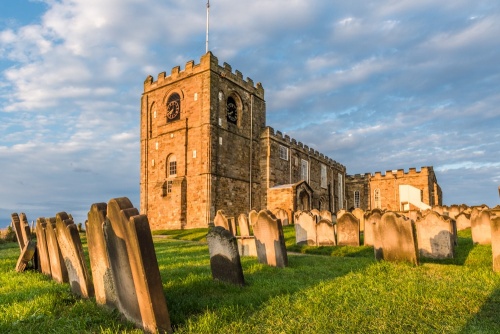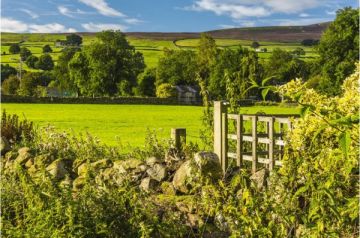
St Mary's Church stands atop Whitby's windswept East Cliff, between the town and the ruins of Whitby Abbey. The church was founded about AD 1100, but the interior furnishings are Georgian, dating to the late 18th century.
St Mary's stands at the top of Whitby's famous Church Steps, a flight of 199 steps linking the clifftop to the town and harbour below. The church is famous for its links to seafarers like Captain Cook, who worshipped here, and as a setting for Bram Stoker's vampire novel, Dracula.

History
Though the church we see today is a product of the early 12th century, there has been a place of worship atop the cliffs since at least the 7th century AD. In AD 664 the Synod of Whitby met on or near this spot to debate the relative merits of the Celtic and the Roman Catholic forms of worship. Roman Catholicism won the day.
The Celtic minster church may have stood on this spot, but a Danish raid in the 9th century destroyed the monastery and minster.
The abbey was re-founded by Benedictine monks and it was the monks who rebuilt the church to serve the parishioners of the fishing port below. The church is older than the 13th-century abbey ruins on the headlands above.
The nave, chancel, and west tower date from the 12th-century building. North and south transepts were added in the 13th and 14th centuries, while battlements were added around the roofline in the Tudor period.

The tower was originally taller, but the top stage was taken down in the 17th century because it was thought to be unstable. As a result, the low, squat tower looks oddly out of proportion to the rest of the church.
Internal galleries were installed in the 19th century, reached by external stairs. Also added were the striking triple-decker pulpit and the box pews that dominate the interior. Look for a huge set of hearing trumpets on the back of the pulpit. They were used by a former rector's wife who was hard of hearing.
Beside the pulpit is an impressive Victorian cast-iron stove, which still provides the only form of heating inside the church. Also near the pulpit is a small font in neoclassical style, probably dating to the late 18th century.
The Victorian architects seemed determined to cram pews into every corner of the church. As a result, St Mary's can seat an astonishing 3,000 people.

The churchwardens came up with a clever way to pay for the restoration; they put the pews up for auction. The money raised at auction helped pay for the church refurbishment. Larger, more luxurious pews near the pulpit went for a higher price.
A few plain, unadorned pews at the back of the church were reserved for poor parishioners. These are marked 'Free' on the pew doors. There was a special pew for the church maid and others for strangers to the church (marked 'For Strangers Only').
One of the Church Maid's duties was to keep the privately-owned pews clean. Because of the church's position on the cliff above the town, smoke from residential chimneys near the harbour would rise up and then settle on the pews, meaning that anyone sitting there would be quickly covered in soot and dust. The Church Maid kept the pews covered before and after services.
On the north side are pews for nearby villages who did not have their own parish church and had to travel to Whitby to worship. Each of these pews is marked with a village name.

There was also a special pew for the Cholmley family, who bought the Whitby Abbey site after the Dissolution of the Monasteries and transformed thew monastic buildings into an elegant mansion. The Cholmley pews occupied a prominent position between the chancel arch and the nave, and blocked direct views of the high altar. It was supported on barley sugar columns and reached by an external stair.
Flanking the chancel arch are two 15th-century fonts discovered being used as livestock troughs at a local farm.
The church has never had electricity and is lit only by candles on sconces and a large brass chandelier.
Over the chancel arch is an 18th-century royal coat of arms. Unusually, there is a second royal coat of arms over the west door. Also near the door is a peculiar 'vamp horn', a Jacobean megaphone used by the choirmaster. Against the north wall are painted boards depicting the Lord's Prayer and the Ten Commandments. More painted 18th-century boards bearing Biblical texts hang on the walls.

In a north extension is a studded oak chest used for storing parish valuables. It dates to at least the 15th century. The chest was stolen in 1743 and thrown over the cliff by thieves. It was recovered from the base of the cliff but all the valuables had disappeared.
While the nave is largely Georgian, the chancel was left relatively untouched and you can see the Norman windows and stonework. The altar is Tudor, but the stained glass windows are by the Victorian artist Charles Eamer Kempe.
There are several carved medieval stones on display, as well as a broken section of a stone Saxon child's coffin.
Captain Cook
St Mary's is known for its links to Captain James Cook, the 18th-century seafaring explorer and cartographer. Cook was apprenticed to a shipowner in Whitby from 1746-49 and lived here for another six years after that before joining the Royal Navy. He worshipped at St Mary's, but sadly, we don't know where he sat.
That is the most frequently asked question of church volunteer guides. All we know is that Cook and his fellow apprentices would have worshipped at St Mary's. They would have climbed the famous 199 Steps from the town to the church, just as modern visitors do.

Dracula
St Mary's is a popular destination for readers of Bram Stoker's novel Dracula. The author set a scene from the novel in the churchyard. The association with Dracula makes St Mary's churchyard a gathering place for costumed characters during Whitby's annual Goth Weekend, one of the largest Goth gatherings n the world.
Getting There
St Mary's church stands atop East Cliff at the top of the Church Steps. The steps were used by coffin-bearers carrying heavy wooden coffins to the churchyard for burial. The church and the steps are well signposted from around central Whitby. You can also reach the church from Whitby Abbey on the clifftop above the church.
There is a large car park beside the abbey and another car park near the harbour. The church is normally open to visitors during daylight hours. It is one of the most heavily visited churches in England.
About Whitby, St Mary's Church
Address: Abbey Plain,
Whitby,
Yorkshire,
England, YO22 4JT
Attraction Type: Historic Church
Location: At the top of the 199 Steps between the harbour and Whitby Abbey. Vehicle access via Abbey Lane along the clifftop.
Website: Whitby, St Mary's Church
Location
map
OS: NZ901112
Photo Credit: David Ross and Britain Express
HERITAGE
 We've 'tagged' this attraction information to help you find related historic attractions and learn more about major time periods mentioned.
We've 'tagged' this attraction information to help you find related historic attractions and learn more about major time periods mentioned.
Find other attractions tagged with:
NEARBY HISTORIC ATTRACTIONS
Heritage Rated from 1- 5 (low to exceptional) on historic interest
Whitby Abbey - 0.1 miles (Abbey) ![]()
Captain Cook Memorial Museum - 0.2 miles (Museum) ![]()
Fylingdales, St Stephen's Old Church - 4.3 miles (Historic Church) ![]()
Grosmont, St Matthew's Church - 5.9 miles (Historic Church) ![]()
Thomason Foss - 7.2 miles (Countryside) ![]()
Mallyan Spout - 7.9 miles (Countryside) ![]()
Goathland, St Mary's Church - 8 miles (Historic Church) ![]()
Beggar's Bridge - 8.1 miles (Historic Building) ![]()
Nearest Holiday Cottages to Whitby, St Mary's Church:
More self catering near Whitby, St Mary's Church











